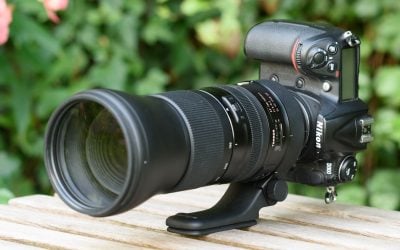Tamron 150-600mm G2 review
-
-
Written by Thomas
In depth
The Tamron SP 150-600mm f/5-6.3 Di VC USD G2 is a super-telephoto zoom lens available for Canon, Nikon and Sony A-mount bodies. Announced in September 2016, it’s the second generation model from Tamron and identified by the A022 code compared to the A011 for the original version; the new model is also known as the G2 version.
The new version not only sports a slightly modified optical formula but also other interesting upgrades including superior coatings, shorter minimum object distance, faster focus, better image stabilization, and compatibility with Tamron’s TAP-in console to update the lens’s firmware and customize AF and VC, to name just a few. But it also comes at a considerably higher price than the A011 model which stays in Tamron’s catalog. Thus Tamron now mirrors Sigma’s dual-pronged strategy with a higher-end model at around 1600 EUR street price and a more affordable version at around 900 EUR. Interestingly both Canon and Nikon have no matching super-telephoto zooms in their catalogs: both offer 80-400mm zooms and Nikon has a 200-500/5.6 lens but none of their zooms reach 600mm.
In my review of the Nikon AF-S 200-500/5.6E ED VR I included comparisons with both Sigmas and Tamron’s A011 lens. The latter sported quite impressive performance at an affordable price. So the question is whether the improvements of the new A022 model show – and justify the mark-up in price? To find out I’ve been testing the new Tamron SP 150-600mm f5-6.3 VC A022 against its older A011 sibling on the demanding Nikon D810 body.
PS – don’t forget you can support my work next time you order anything at Amazon, B&H or Adorama by first clicking through to them using the links above and in the sidebar. It works for anything you order at any time – thanks for your support!
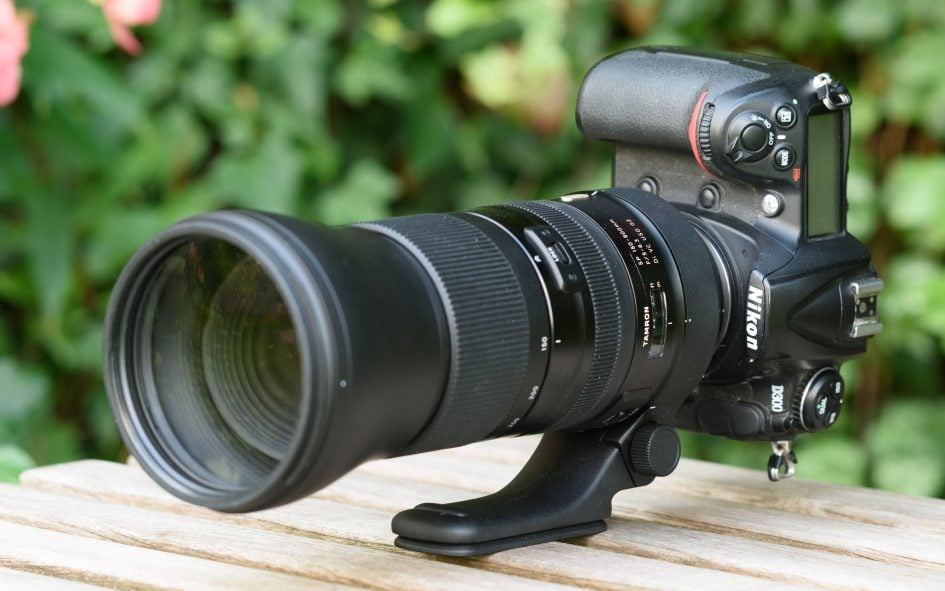
Facts from the catalog
As usual I’ll have a look at the technical data first. I’ve rated the features with a [+] (or [++]), when it’s better than average or even state of the art, a [0] if it’s standard or just average, and [-] if there’s a disadvantage. I’ll compare it mostly with Tamron’s A011 model and the Sigma’s 150-600/5.0-6.3 DG OS HSM Sports or Contemporary (the “Sigma Sports” or “Sigma Contemporary” for short).
Size (diam. x length): 108 x 258mm (4.3 x 10.2in). Add another 97mm for the hefty lens-hood and zoom-in to 600mm focal length (+79mm) and you end up at a total length of 434mm (17.1in). But the Sigma Sports is still considerably bigger at 121 x 290mm (w/o hood at 150mm focal length) extending to 46cm (18.3in) with attached lens-hood at 600mm focal length. The Tamron A011 is of the same length, only the Sigma Contemporary is a bit shorter. [0]
Weight: 1990g (70.2oz.). This is more or less the same as for the Sigma Contemporary and the Tamron A011. Add the lens hood (+108g) and a D810 to it and you’re at 3kg. That’s not easy to carry around on a shoulder-strap all day. The Sigma Sports weighs a whopping 2,860g (+ 292g for the lens hood) and lets you attach straps to the lens. [0]
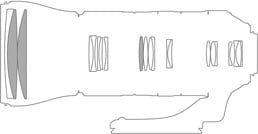
Optics: 21 elements in 13 groups. It looks the same as the optical formula of the A011 model with one additional element at the rear. The Sigma Sports with 24 elements in 16 groups is a bit more complex. The new lens has three low dispersion elements, improved anti-reflective coating using nanotechnology, and fluorine coating on the front element for easier cleaning. The lens sports an electromagnetic aperture mechanism now also for Nikon mount that should result in faster and more precise control of the aperture. [+]
Closest focus distance/max. magnification: 2.2m (7.2ft) / 1:3.9. In my test I could go down to 2.0m / 1:3.5 with manual focusing at 600mm. That’s better than the 1:5 magnification the Sigma Sports or the Tamron A011 achieve with AF and still gives you a working distance of 1.6m (5.3ft). From a focus distance of 5m (16.4ft) the magnification of the new Tamron at 600mm is 1:8.8, similar to the Sigma Sports with 1:9.0. [0]
Tele converter: Tamron also offers two brand new tele converters which were specifically designed for use with the new A022 model – which is currently the only listed compatible lens. The TC-X14 transforms the A022 model into a 210-840mm f7-8.8 lens which should normally still auto-focus on modern bodies. It retains the minimum focus distance of 2.2m and increases the maximum magnification to 1:2.8. The tele converter has 6 elements in three groups and adds another 200g The TC-X20 produces a 300-1200mm f10-12.6 lens which should auto-focus in live view only. [0]
Filter-thread: 95mm. That’s larger than most of us have filters for and may mean that you need to get new filters for the lens. But that’s par for the course as both the Sigma Contemporary and the Tamron A011 need 95mm filters. The Sigma Sports needs 105mm filters which are even more expensive. [0]
Image Stabilization: Yes, except for Sony A-mount. Tamron claims their VC yields 4.5 stops of stabilization which should be an improvement over the A011 model. It can be switched off and offers three mode: mode 1 = normal, mode 2 is recommended when tracking moving objects, mode 3 offers no stabilization of the viewfinder image but prioritizes the stabilization of the captured images. Mode 3 is said to have the greatest stabilizing effect. The competition also has stabilization, dubbed “OS” with Sigma and “VR” with Nikon but all of their stabilization modes also work for the viewfinder image. [+]
Auto Focus: USD (ultra sonic drive). Manual-focus override is by simply turning the focus ring. Same with the competition. The lens offers a focus limiter which can be set to “full”, “infinity – 10m” or “10m – 2.2m” to limit hunting. Both Sigmas offer the same. [+]
Covers full frame/FX or smaller = very good. Same with the competition. [+]
Price: around 1600 EUR new (incl. 19% VAT), same as the Sigma Sports. Both the Tamron A011 and Sigma Contemporary are much cheaper. The new tele converters both have an exorbitant asking price of 650 resp. 700 EUR. [-]
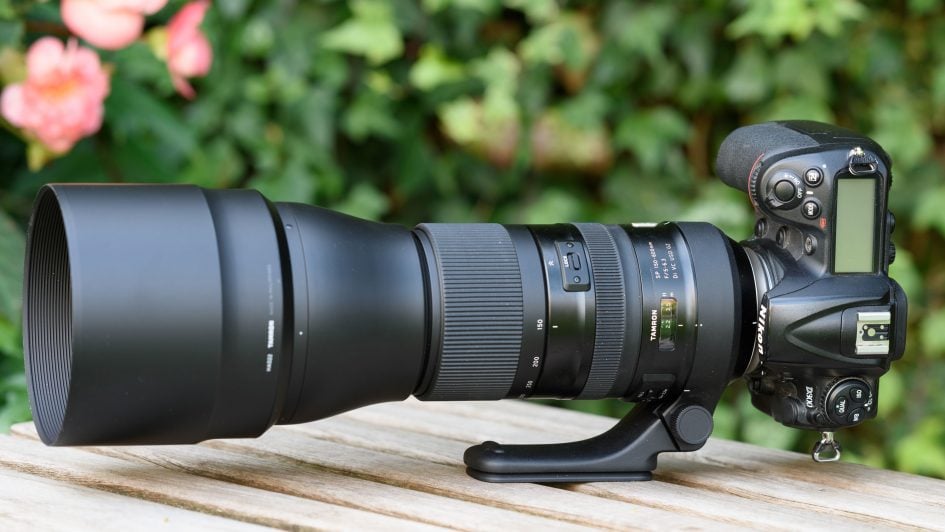
Comes with a soft pouch and a removable tripod-collar that has an Arca-Swiss style tripod interface. The lens hood is included and reversible for transport, the lens caps are standard Tamron’s. The Sigma 150-600 Sports has a nicer and well padded lens case and the carton of the lens can be converted to a carrying box. But you can only remove the foot of the tripod-collar. [+]
Distance information is relayed to the camera, so the Tamron body can do all the advanced exposure-related stuff with this lens. Same with the competition. [+]
Aperture ring: no. Same as with all the other alternatives. [0]
Sealing: yes. A rubber grommet at the lens-mount and a rubberized front-end that acts as a seal when the lens-cap is attached. Plus there are other “leak proof” seals throughout the lens barrel. The Sigma Sports also offers a very high degree of sealing. [+]
The score in the “features-department” is 1[-]/6[0]/7[+]. The minus-point being the high price. All in all there’s not much to differentiate Tamron’s newest offering from the competition.
A selection of super-telephoto zoom alternatives
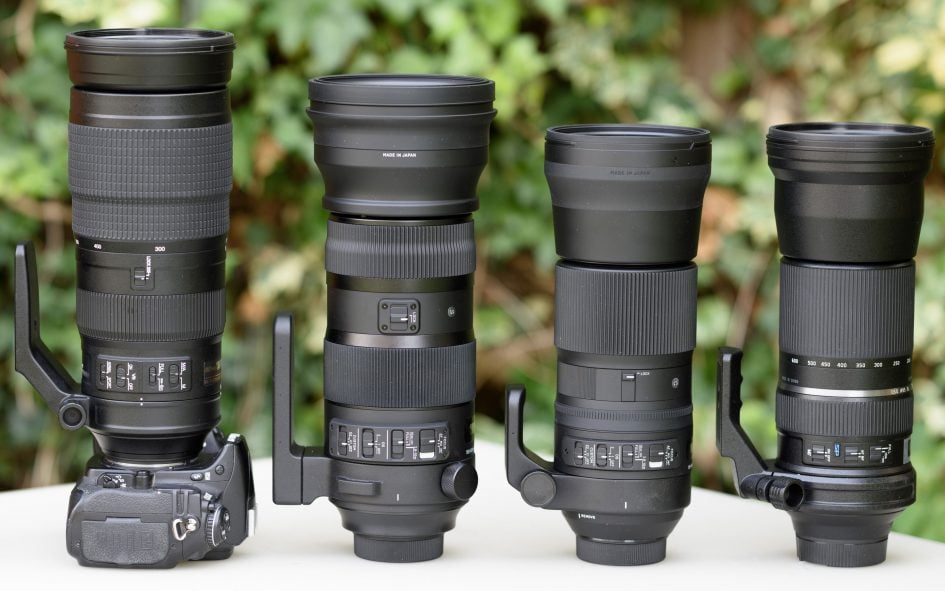
Above from left to right: Nikon 200-500mm, Sigma 150-600mm Sports + Contemporary, Tamron 150-600mm A011
Here is the field of view that a 150-600mm zoom covers:
Coverage of a 150-600mm zoom on a full frame body

Above left: at 150mm, above right: at 600mm
The building in the center is about 1km away! And if you use the TC-X14 or TC-X20 teleconverter you can even reach further:
Reach of a 150-600mm zoom with teleconverter on a full frame body

Above left: with TC-X14 teleconverter at 850mm, above right: with TC-X20 teleconverter at 1200mm
Alternatives:
– For users of Nikon DSLRs there’s the AF-S 200-500mm f5.6E ED VR. It’s a fine lens and got a Highly Recommended in my Nikon 200-500mm f5.6 ED VR review. Interestingly its street price of 1400 EUR actually puts it below the top models from Tamron and Sigma. But you have to give up 50mm focal length on the wide end and 100mm at the long end. That may be a deciding factor for you.
– The most obvious alternative is Tamron’s own SP 150-600mm F/5-6.3 Di VC USD model A011 announced Dec 2013. It basically offers the same functions as the new model A022 and currently sells for around 900 EUR which is only little more than half the street-price of the new model A022. So you need to look very closely at any differences in performance and features, which I’ll round up in my verdict. You can see a set of test-shots in my Tamron 150-600mm A011 album.
2nd generation vs. 1st generation
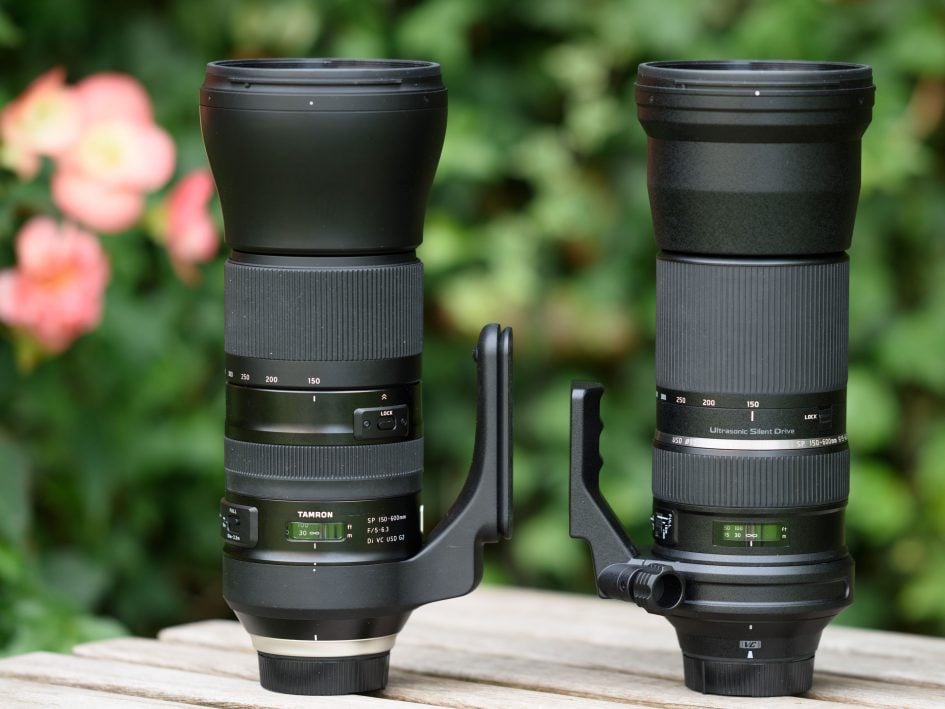
Above left: Tamron 150-600mm G2 (A022) from 2016, above right: Tamron 150-600mm A011 from 2013
Sigma offers two equivalent lenses in this category: The 150-600mm f5-6.3 DG OS HSM Contemporary (900 EUR, see my set of test-shots in my Sigma 150-600mm Contemporary album), and the 150-600mm f5-6.3 DG OS HSM Sports (around 1600 EUR, see Gordon’s Sigma 150-600mm Sport review and my set of test-shots). Plus the 50-500mm f4.5-6.3 DG APO OS HSM which has the largest zoom-range of all alternatives and goes for around 1000 EUR. But with only 500mm focal length it offers 20% less magnification. If you crop the images from 500mm to get the same field of view as at 600mm you’ll lose 30% of your pixels. On the other hand you get a minimum focal length of only 50mm which makes this lens more flexible than zooms starting at 150mm. It’s a very versatile lens and loved for that but optically it’s a dated design: don’t expect wonders in image quality on today’s high mega-pixel sensors.
I’ve compared all of the above mentioned alternatives apart from Sigma’s 50-500mm. So if you want to get a good impression of their performance head over to in my Nikon 200-500mm f5.6 ED VR review.
Focus, build quality, and image stabilization
Focus accuracy and repeatability is critical to consistently produce sharp shots. Repeatability (the accuracy of focus on the same subject after repeated focus-acquisition) of this lens is very good (measured 98.0% in Reikan FoCal) with no outliers over a series of 40 shots. And there is no performance variation whether the lens focuses from infinity or from a closer distance. At 500mm focal length the lens focuses in around 0.7 sec from infinity to 5m, which is pretty fast although the lens starts searching in the wrong direction (beyond infinity) on my test target before turning around. Without hunting the lens focuses in less than 0.5 sec which is very good.
The focus ring has no slack/play between its movement and the focus-action and a throw of 120 degrees. The focus ring moves smoothly. It is 24mm broad and easy to grip although only 14mm of that is ribbed. The zoom ring turns through 140 degrees with medium stiffness, its rubber surface is 40mm wide. You can also operate the zoom in push-pull mode grabbing the front end which is pretty easy between 150mm and 450mm but gets a little stiff beyond that. I asked technical marketing at Tamron whether they would advise against this method but they said it’s OK. The zoom also offers another nice feature: with a push of the zoom ring you can lock the zoom at any position in addition to the usual hard zoom-lock at 150mm. The Sigma Sports can do this only at certain focal lengths.
AF-operation is barely audible from the outside, and if you record video with the built-in microphone the AF-drive produces a slight whir but there are no clicks at the start or stop of focus-movements. The VC-system is virtually silent both on the outside and when recording video. Very good!
The tripod-collar and mount is made of magnesium and weighs 199g which is 70g lighter than the foot of the A011 model. The base-plate is 93mm long and extends about 25mm below the zoom ring so it might get in the way of zooming all the way from 150mm to 600mm – another reason to operate the zoom in push-pull mode. The foot can be completely removed from the lens when you’ve detached the lens from the camera.
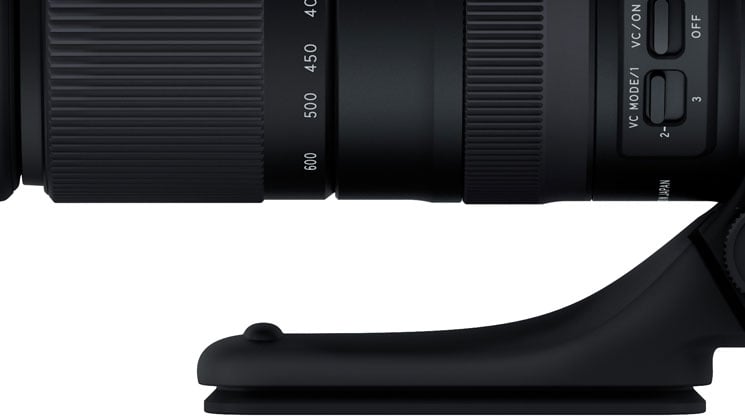
In general the impression of build quality is that of an upmarket/enthusiast albeit not pro-level lens: The construction is metal on the outside from the lens mount up to the focus ring and between focus ring and zoom ring. The extending zoom barrel does not wobble and is made of plastic and the front end is also plastic with a nice coating. How well this stands up to everyday use remains to be seen. The lens has nine rounded aperture blades and is weather sealed at the metal lens-mount, the front lens cap, and at various points throughout the lens barrel. Overall the build quality of the new Tamron is better than the A011 model but still below that of Sigma’s Sports version which not only leaves a more solid impression with its hefty weight but also has a very nice tripod-collar: When unlocked you can turn the Sigma Sports very smoothly from portrait to landscape orientation and it offers click-stops at 90 degrees so there’s no need to look at and align the markings on the barrel for this.
To test the effectiveness of the image stabilization I did a series of 1000 test-shots hand-held with two new G2 (A022) models and two A011 models at 600mm and 500mm focal length. The A022 models were tested with VC in mode 3 and mode 1 and shutter speeds were from 1/640 of a second down to 1/40 sec at 600mm and between 1/500 sec and 1/30 at 500mm. Shots at 1/640 sec resp. 1/500 sec with VC=OFF are used as reference of how good my hand-holding was at the time of the test and Reikan FoCal did the chore of evaluating the sharpness of all shots. In general I can report that the VC of the new lens is good for around 3 stops of image-stabilization. And the number of usable shots at 1/40 sec resp. 1/30 sec (4 stops) is still pretty high but you better do a series of shots at that shutter speeds to increase your chances of getting a good one. There are other observations from this extensive image stabilizer test:
– Mode 3 had the advantage over mode 1 with the G2 (A022) model of the lens at 600mm. But at 500mm the results were a bit mixed in my tests: Mode 3 performed better at shorter shutter speeds but at 1/60 sec mode 1 looked better.
– There’s an interesting side-effect of mode 3: when the viewfinder image is not stabilized one tends to practice a better and more stable hand-holding technique because you can easily see how bad you shake otherwise. I commend Tamron on being so bold to forfeit stabilization of the viewfinder image completely in mode 3. If you don’t like it you can simply use mode 1 or mode 2.
– The A011 model fared pretty well too. Its stabilizer even surpassed the results of the A022 model at 500mm and 1/250 sec and 1/125 sec. And at 600mm its performance peaked at 1/160 sec where it again performed better than the new A022 model in my tests.
All-in-all the results from the image stabilizer tests are very good – although not a clear-cut win over the older A011 model.
Check prices on the Tamron 150-600mm G2 at Amazon, B&H, Adorama, or Park Cameras. Alternatively get yourself a copy of my In Camera book or treat me to a coffee! Thanks!
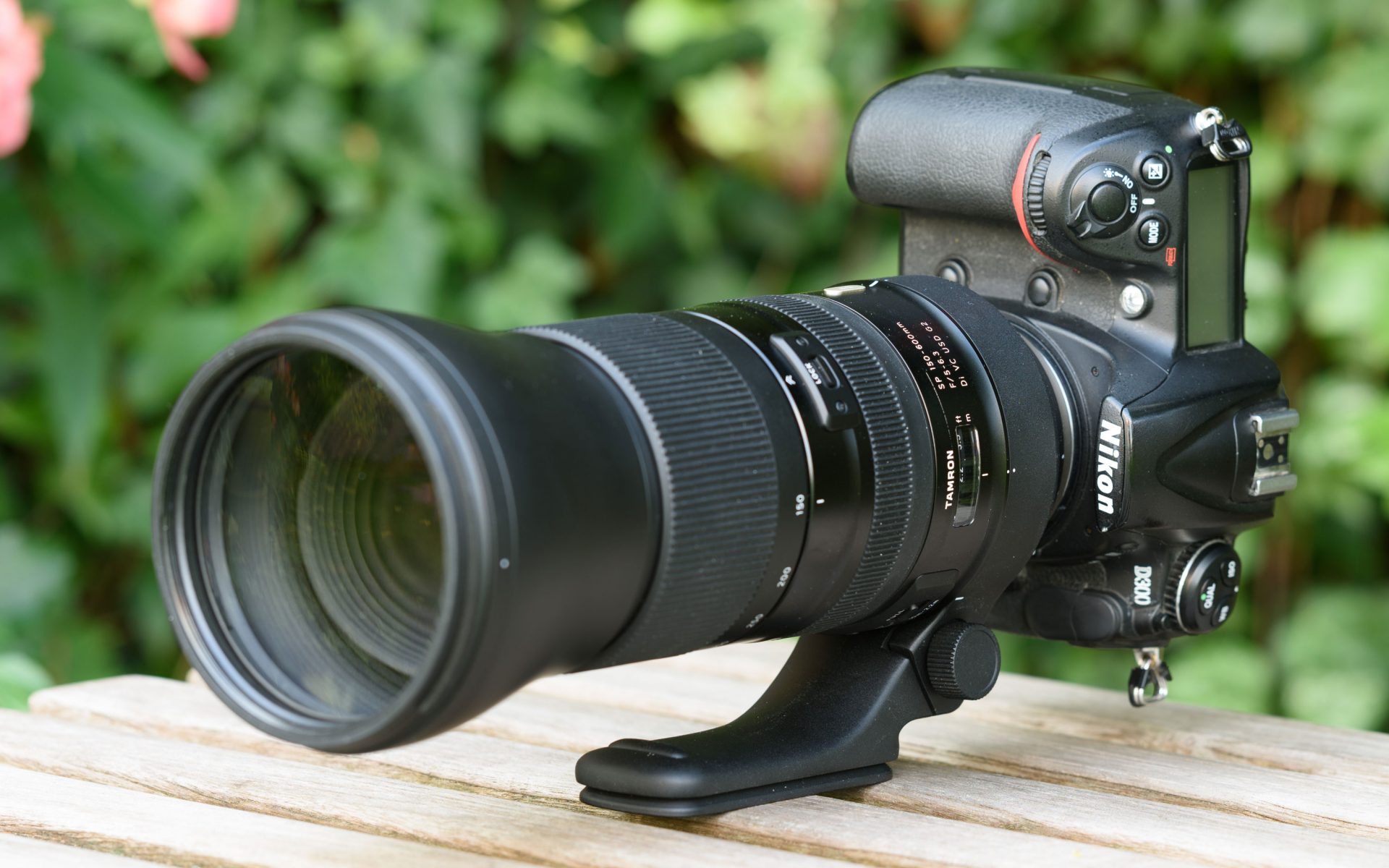
 Improved image quality combined with good image stabilization, improved sealing, shorter minimum focus distance, and an acceptable size and weight makes Tamron's new 4x super-telephoto a compelling package. It's a pity that Tamron didn't position it as the successor to their A011 model at the same price-point. But it certainly earns a Recommended rating.
Improved image quality combined with good image stabilization, improved sealing, shorter minimum focus distance, and an acceptable size and weight makes Tamron's new 4x super-telephoto a compelling package. It's a pity that Tamron didn't position it as the successor to their A011 model at the same price-point. But it certainly earns a Recommended rating.



